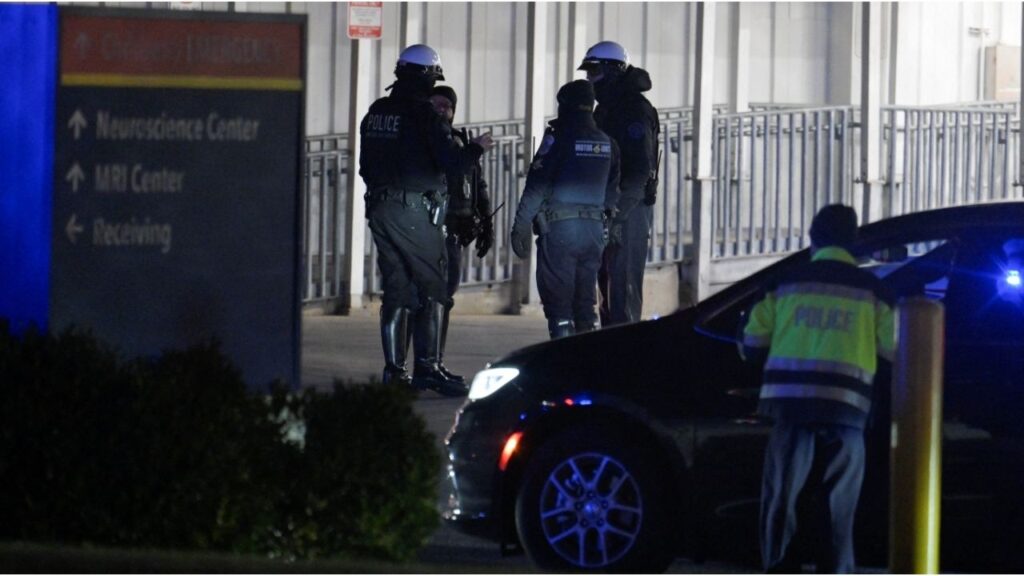Share
YELLOWSTONE NATIONAL PARK, Wyo. — The saucer-sized footprints in the mud around the bloody, disemboweled bison carcass were unmistakable: wolves.
A pack of 35 named after a nearby promontory, Junction Butte, now were snoozing on a snow-dusted hillside above the carcass. Tourists dressed against the weather watched the pack through spotting scopes from about a mile away.
“Wolves are my main thing. There’s something about their eyes — it’s mystifying,” said Ann Moore, who came from Ohio to fulfill a life-long wish to glimpse the animals.
Such encounters have become daily occurrences in Yellowstone after gray wolves rebounded in parts of the American West with remarkable speed following their reintroduction 25 years ago.
It started with a few dozen wolves brought in crates from Canada to Yellowstone and central Idaho. Others wandered down into northwest Montana. Thriving on big game herds, the population boomed to more than 300 packs comprising some 2,000 wolves, occupying territory that touches six states and stretches from the edge of the Great Plains to the forests of the Pacific Northwest.
Now the 2020 election offers an opportunity to jumpstart the wolf’s expansion southward into the heart of the Rocky Mountains. A Colorado ballot initiative would reintroduce wolves on the state’s Western Slope. It comes after the Trump administration on Thursday lifted protections for wolves across most of the U.S., including Colorado, putting their future in the hands of state wildlife agencies.
The Colorado effort, if successful, could fill a significant gap in the species’ historical range, creating a bridge between the Northern Rockies gray wolves and a small Mexican gray wolf population in Arizona and New Mexico.
“Colorado is the mother lode, the final piece,” said Mike Phillips, who led the Yellowstone reintroduction project and now serves in the Montana Senate.
Wolf Fears in Colorado
Yet the prospect of wolves is riling Colorado livestock producers, who see the predators as a threat their forbears vanquished once from the high elevation forests where cattle graze public lands. Hunters worry they’ll decimate herds of elk and deer.
It’s a replay of animosity that broke out a quarter-century ago when federal wildlife officials released the first wolves into Yellowstone. The species had been annihilated across most of the contiguous U.S. in the early 1900s by government-sponsored poisoning, trapping and bounty hunting.
Initiative opponents have seized on sightings of a handful of wolves in recent years in northwestern Colorado as evidence the predator already has arrived and reintroduction isn’t necessary.
“We can live with a few wolves. It’s the massive amount that scares me,” said Janie VanWinkle, a rancher in Mesa County near Grand Junction, Colorado.
VanWinkle’s great grandparents shot wolves up until the early 1940s, she said, when the last wolves in Colorado were killed. The family runs cattle on two promontories with names from that era — Wolf Hill and Dead Horse Point, where VanWinkle said her great grandfather’s horse was killed by wolves while he was fixing a fence.
“I try to relate that to millennials: That would be like someone stealing your car,” she said. “He had to walk home 10, 15 miles in the dark, carrying his saddle, knowing there’s wolves out there. So of course they killed wolves on sight.”
Mesa County’s population has increased more than five-fold since wolves last roamed there, to more than 150,000, and VanWinkle sees little room for the animals among farms in the Colorado River valley and the growing crowds of backcountry recreationists on the Uncompahgre Plateau.
Colorado’s population is approaching 6 million — almost twice as much as Idaho, Montana and Wyoming combined — and is expected to surpass 8 million by 2040.
“Things have changed,” VanWinkle said.
The pack that showed up in northwest Colorado last year is believed to have come from the Northern Rockies through Wyoming, where wolves can be killed at will outside the Yellowstone region.
Even with protections under the Endangered Species Act, thousands of wolves were shot over the past two decades for preying on livestock and, more recently, by hunters.

Yellowstone Recovery
But rancor that long defined wolf restoration in the region has faded somewhat since protections were lifted in recent years. Opponents were given the chance to legally hunt wolves, while advocates learned state wildlife officials weren’t bent on eliminating the animals from the landscape as some had feared.
“I’ve got a simple message: It’s not that bad,” said Yellowstone wolf biologist Doug Smith, who with Phillips brought the first wolves into the park in 1995 and has followed their impacts on the landscape perhaps as closely as anyone.
“I got yelled at, at public meetings,” he said. “I got phone calls: ‘They are going to kill all the elk and deer!’ Where are we 25 years in? We still have elk and deer.”
On a cold October morning, after examining remains of the bison eaten by the Junction Butte pack near a park road, Smith asked a co-worker to have the carcass dragged deeper into brush so it wouldn’t attract wolves and other scavengers that could be hit by a vehicle.
Later, as the sun struggled to break through cloud banks, he hiked up a trail in the park’s Lamar River valley to where the first wolves from Canada were released.
The animals initially were kept in a large outdoor pen to adjust to their new surroundings. The pen’s now in disrepair, sections of chain-link fence crushed by fallen trees. But Smith was able to show where wolf pups had once tried to dig their way out , and another spot outside the enclosure where some freed adult wolves had tried to dig back in.
All around were young stands of aspen trees. The area had been overgrazed by elk during the years when wolves and most grizzly bears and cougars were absent — direct evidence, Smith said, of the profound ecological impact from the predators’ return.
Europe Debates Wolf Return
Yellowstone’s experience with wolves has spurred debate among European scientists over whether a gradual comeback of wolves on the continent could also revitalize landscapes there, and be welcomed or at least tolerated by local people, said Frans Schepers, with Rewilding Europe, which works to restore ecosystems in multiple countries. There have been no European wolf reintroductions to date, but land-use changes coupled with fewer hunting and poisoning campaigns have allowed populations to begin rebounding naturally in several countries.
Since 2015, wolf packs that traveled over the Baltics have established three or four packs in the Netherlands and packs in neighboring Germany and Belgium. Government programs provide money for Dutch farmers to erect fences to deter wolves.
In the British Isles, where the last wolves were exterminated in the 1700s, a wilderness reserve in Scotland is seeking permission to bring wolves to about 78 square miles (200 square kilometers) of fenced enclosure to help control a runway deer population and draw tourists.
Alladale Wilderness Reserve owner Paul Lister views Yellowstone, where wolves controlled elk numbers, as a model.
“All the native predators are gone,” Lister said of the Scottish reserve.
The Ballot Battle
In Colorado, hunting outfitter Dean Billington foresees economic disaster if the 2020 wolf initiative passes. His Kremmling-based Bull Basin Guides & Outfitters is ideally situated for one of the state’s largest trophy elk herds, the White River elk herd. He estimates his firm alone spends more than $250,000 a year for hunting leases on ranches.
“They’re land wealthy and day-to-day poor,” Billington said of ranch owners. “This income keeps the western ranching guys afloat.”
The initiative calls for initially introducing 10 wolves annually by Dec. 31, 2023, with a goal of 250 wolves within a decade.
“You’re putting wolves in my backyard,” Billington said of supporters of the reintroduction initiative. “They say they’ll compensate for lost cattle and sheep, but how would it feel for these people in Denver if their dog in the back yard was mauled to death by the wolf and someone throws a few bucks at you to make you feel better?”
Rob Edward with the Rocky Mountain Wolf Action Fund, the group behind the initiative, sees reintroduction as a national rather than state issue since it involves public lands that account for 70% of western Colorado.
“Colorado’s public lands are diminished without wolves,” he said.
The Yellowstone experience is key to his group’s arguments: Reintroduction restores balance to the ecosystem, improves wildlife habitat and will benefit hunters by thinning out weaker prey.
Standing in the decaying pen where Yellowstone’s wolves got their start, Smith said that if the Colorado reintroduction initiative passes, success ultimately rests more on human tolerance than the animals’ proven biological resiliency.
“Don’t recover wolves unless there’s areas where you can leave them alone,” he said.
RELATED TOPICS:
Categories

Reedley Repeat Drunk Driving Suspect Charged With Murder


















